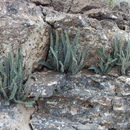Comments
provided by eFloras
R. H. Hevly (1965) hypothesized that Astrolepis integerrima was produced by hybridization between A . cochisensis and A . sinuata . Recent isozyme analyses (D. M. Benham 1989) indicate, however, that Astrolepis integerrima is an apogamous allotriploid hybrid between A . cochisensis and an unnamed Mexican taxon related to A . crassifolia (Houlston & T. Moore) D. M. Benham & Windham. Two morphologic forms exist in this taxon: one with essentially entire pinnae, and one (more common in the United States) with larger, asymmetrically lobed pinnae. The former might be confused with A . cochisensis on occasion, but the abundance of adaxial scales and the larger pinnae of A . integerrima should serve to distinguish these species. The lobed form of A . integerrima is superficially similar to A . windhamii , from which it is distinguished by the abundance and greater width of adaxial scales and the asymmetrical lobing of the pinnae.
- license
- cc-by-nc-sa-3.0
- copyright
- Missouri Botanical Garden, 4344 Shaw Boulevard, St. Louis, MO, 63110 USA
Comments
provided by eFloras
Recent isozyme analyses (D. M. Benham 1989) indicate that Astrolepis windhamii is an apogamous allotriploid that contains three different genomes, one each from A . sinuata , A . cochisensis , and an unnamed Mexican taxon related to A . crassifolia . Because of this genomic constitution, Astrolepis windhamii tends to bridge the morphologic gap between A . sinuata and A . integerrima , which is itself a hybrid between A . cochisensis and the unnamed Mexican species. Although the features that separate these taxa are subtle, the pinna lobing and scale characteristics of A . windhamii mentioned in the key adequately distinguish them in most cases.
- license
- cc-by-nc-sa-3.0
- copyright
- Missouri Botanical Garden, 4344 Shaw Boulevard, St. Louis, MO, 63110 USA
Description
provided by eFloras
Stems compact; stem scales uniformly tan or somewhat darker near base, to 15 mm, margins ciliate-dentate to entire. Leaves 8--45 cm. Blade 1-pinnate to pinnate-pinnatifid, pinna pairs 20--45. Pinnae oblong to ovate, largest usually 7--15 mm, entire or asymmetrically lobed, lobes 2--7, broadly rounded, separated by shallow sinuses; abaxial scales concealing surface, lanceolate, usually 1--1.5 mm, ciliate with coarse marginal projections; adaxial scales abundant, mostly persistent, stellate to coarsely ciliate, elongate, attached at base, body mostly 5--7 cells wide. Sporangia containing 32 spores. n = 2 n = 87, apogamous.
- license
- cc-by-nc-sa-3.0
- copyright
- Missouri Botanical Garden, 4344 Shaw Boulevard, St. Louis, MO, 63110 USA
Description
provided by eFloras
Stems compact to short-creeping; stem scales uniformly tan or somewhat darker near base, to 15 mm, margins ciliate-dentate to entire. Leaves 10--50 cm. Blade pinnate-pinnatifid, pinna pairs 20--45. Pinnae ovate to deltate, largest 7--15 mm, usually symmetrically lobed, lobes 6--11, broadly rounded, separated by shallow sinuses; abaxial scales concealing surface, lanceolate, usually 1--1.5 mm, ciliate with coarse marginal projections; adaxial scales sparse, mostly persistent, elongate, usually stellate, attached at base, body 2--4 cells wide. Sporangia containing 32 spores. n = 2 n = 87, apogamous.
- license
- cc-by-nc-sa-3.0
- copyright
- Missouri Botanical Garden, 4344 Shaw Boulevard, St. Louis, MO, 63110 USA
Distribution
provided by eFloras
Ariz., Nev., N.Mex., Okla., Tex.; n,c Mexico.
- license
- cc-by-nc-sa-3.0
- copyright
- Missouri Botanical Garden, 4344 Shaw Boulevard, St. Louis, MO, 63110 USA
Distribution
provided by eFloras
Ariz., N.Mex., Tex.; n Mexico.
- license
- cc-by-nc-sa-3.0
- copyright
- Missouri Botanical Garden, 4344 Shaw Boulevard, St. Louis, MO, 63110 USA
Habitat
provided by eFloras
Sporulating summer--fall. Rocky hillsides and cliffs; usually on limestone or other calcareous substrates; 500--1800m.
- license
- cc-by-nc-sa-3.0
- copyright
- Missouri Botanical Garden, 4344 Shaw Boulevard, St. Louis, MO, 63110 USA
Habitat
provided by eFloras
Sporulating summer--fall. Rocky hillsides and cliffs; occurring on calcareous and noncalcareous substrates; 1200--2100m.
- license
- cc-by-nc-sa-3.0
- copyright
- Missouri Botanical Garden, 4344 Shaw Boulevard, St. Louis, MO, 63110 USA
Synonym
provided by eFloras
Notholaena sinuata (Lagasca ex Swartz) Kaulfuss var. integerrima Hooker, Sp. Fil. 5: 108. 1864; Cheilanthes integerrima (Hooker) Mickel; Notholaena integerrima (Hooker) Hevly
- license
- cc-by-nc-sa-3.0
- copyright
- Missouri Botanical Garden, 4344 Shaw Boulevard, St. Louis, MO, 63110 USA

